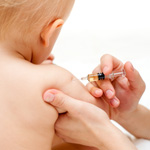The CDC (Centers for Disease Control) reports that their ongoing study reveals that children who get an MMRV vaccine are “twice as likely to have a febrile seizure 7-10 days after getting the shot than children who get MMR and varicella vaccines (2 shots) at the same health care visit.” These concerns affect doctors and nurses concerning publich health and education policies. The MMRV shot is the measles-mumps-rubella-chickenpox combination vaccine and febrile means “relating to fever.”
MMRV vs. MMR Safety
The MMRV vaccine caused 77 febrile seizures out of a sample size of 63,000 children. That is a rate of approximately 1.2 children out of every 1,000 who will have seizures due to the vaccine. The study also looked at children who received the MMR vaccine and a separate V vaccine on the same day instead of the four-in-one combination vaccine. The MMR + V two-shot combination caused 174 febrile seizures out of a sample size of 376,000 children. This is approximately 1 child out of every 2,000 who experience this adverse side effect. The four-in-one MMRV has approximately doubled the chance that a child will have a febrile seizure compared with the two shot combination of MMR + V. The CDC also notes that “children who receive the MMR vaccine are more likely to have febrile seizures 8-14 days after vaccination than children who are not vaccinated at all.”
ProQuad is the trade name for the MMRV vaccine produced by Merk pharmaceuticals. It is licensed for use in children from the ages of 12 months to 12 years old. One in five children have the following side effects from the vaccine: soreness or swelling at the injection site, fever, and rash. The MMRV four-in-one combination shot has a higher incidence of fever and rash compared with using 2 separate shots (MMR + V) to achieve the same level of vaccination protection. The CDC notes that “febrile seizures cannot be prevented” due to the MMRV vaccine.
MMRV Side-Effects
MMRV vaccine combines the attenuated MMR (measles, mumps, rubella) with the chickenpox vaccine (varicella). It is often given to children between 1 and 2 years of age. ProQuad side effects are rare but include allergic reactions, difficulty breathing and closing of the throat, hives, weakness, paleness, dizziness, a rapid heart beat, deafness, long-term seizures, coma, brain damage, febrile seizures, acute and chronic arthritis, and a temporarily low platelet count.
MMR Vaccine Development
The measles and mumps component of the vaccine are grown in hens’ eggs and from chicken embryo cell cultures. These strains of the virus are less virulent than those affecting human cells and are therefore called attenuated strains. The rubella (German measles) component of the vaccine is propagated using a cell line developed from human embryonic lung tissue originally from aborted human fetuses.
Chickenpox-Only Vaccine
The chickenpox component of the vaccine (varicella) contains live attenuated virus. In the US, 9.7 million doses of the chickenpox-only vaccine were distributed between 1995 and 1998. 6,580 reports of adverse effects were reported and only 4% were determined to be serious side effects. About ⅔ of the side effects occurred in children under the age of 10. Rashes were the most commonly reported side effect. Serious side effects were rare but included encephalitis, ataxia, erythema multiforme, Stevens-Johnson syndrome, pneumonia, thrombocytopenia, seizures, neuropathy, and herpes zoster.
Public Health Policy
Public health policy weighs the risks of contracting measles, mumps, rubella, and chickenpox against the risks of adverse effects due to vaccinations. The CDC opines that the dangers of illness due contracting the live diseases is greater than the risk of side effects due to vaccinations. The FDA is responsible for approving the types of vaccines made available to the US public. Evidence suggests that separate vaccines for each disease may be safer than combination vaccines. In Japan, MMR vaccination has been discontinued and has been replaced with single vaccines for each disease. Many healthcare professionals in the US are concerned that if individual vaccines are made available that many children will not receive immunizations for all four diseases. Therefore, a combination vaccine ensures that children are protected from measles, mumps, rubella, and chickenpox simultaneously without any risk that they may not receive all of these shots individually. However, this also increases the risk of side effects due to the vaccination process. Nursing professionals and doctors can base their educational recommendations on balance between broader public health concerns and the individual health concerns of each patient.


